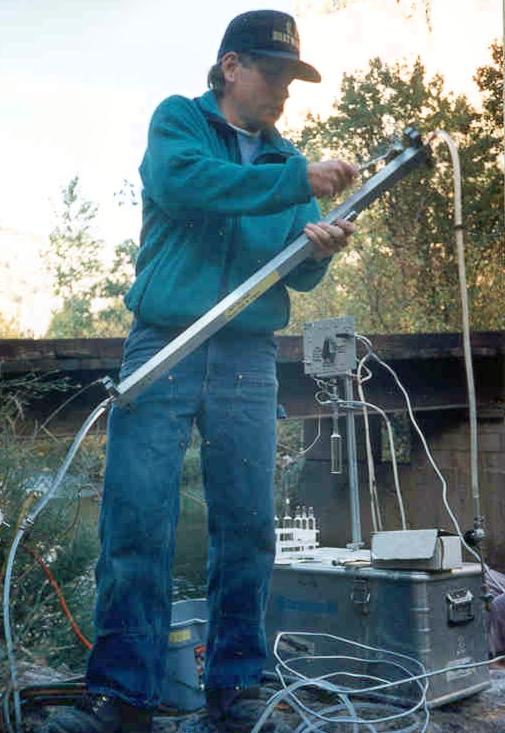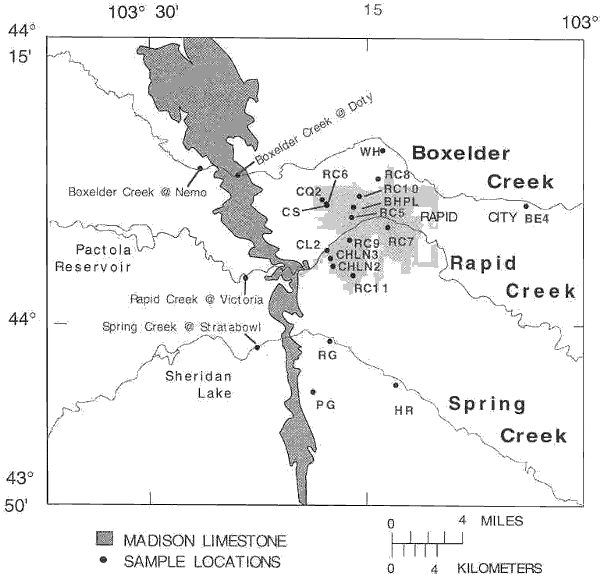South Dakota Research
In This Document:
Summary
The 3H-3He dating technique was applied in the Madison Aquifer in the vicinity of Rapid City, South Dakota; in this area, the Madison Aquifer is a highly heterogeneous fractured and karstic limestone formation recharged by three creeks in separate drainage basins. 3H-3He ages have little meaning in such complex flow systems, but are used in conjunction with tritium and helium concentrations to aid in hydrogeologic interpretations. Tritium concentrations in the creeks that recharge the flow system are higher than expected from modern precipitation due to inputs into the creeks of ground water with high tritium concentrations from flow systems higher in the Black Hills. 3H-3He ages and [3H]+[3Hetrit] concentrations in the samples aided us in determining the dominant sources of water in each well. Wells that sample the Madison Aquifer exclusively, that have low [3H]+[3Hetrit] concentrations, and that have 3H-3He ages between 1960 and 1985, sample a mixture of water that is approximately 10% rapid conduit flow from Boxelder Creek and 90% diffuse flow through small fractures and the rock matrix. Those that have higher [3H]+[3Hetrit] concentrations and similar ages are from wells that receive conduit and diffuse flow from Rapid Creek and Spring Creek. Systematic variations in [3H]+[3Hetrit] concentrations as well as 3H-3He ages in the flow system are controlled by the amount of recharge from each creek in a given location of the flow system and by the different flow controls on the creeks in the three different basins. High concentrations of terrigenic helium in the samples from the central- and southern-most basins result from the proximity to two faults that cut through to the Precambrian rock below the Madison Aquifer. The terrigenic 3He/4He ratio determined using several methods varied by location; it is 4x10-8 in the northern-most fault, 1x10-7 in the southern-most fault and in the wells that are downgradient from this fault, and 6x10-8 in one well located far to the east of the fault region and affected by flow from the northern-most basin that does not have high terrigenic helium concentrations.
Investigators:
Stephanie Dunkle Shapiro (Lamont-Doherty Earth Observatory of Columbia University, Palisades, New York, Department of Earth and Environmental Sciences, Columbia University, New York), Peter Schlosser(Lamont-Doherty Earth Observatory of Columbia University, Palisades, New York, Department of Earth and Environmental Sciences, Columbia University, New York), Martin Stute (Lamont-Doherty Earth Observatory of Columbia University, Palisades, New York, Department of Environmental Science, Barnard College, New York), and Allen M. Shapiro (U.S. Geological Survey, Reston, Virginia)
Publications:
Shapiro, S.D., 1998, Evaluation of the 3H-3He Dating Technique in Complex Hydrologic Environments: Ph.D. Dissertation, 254 p., Department of Earth and Environmental Science, Columbia University in the City of New York.
Illustrations:

Allen Shapiro, USGS, at outcrop of Madison Limestone, South Dakota

Earl Greene, USGS, 3H-3He and CFC Sampling

Map of study area showing location of Madison outcrop, sampling sites, creeks, Pactola Reservoir, and Sheridan Lake.

Neon concentrations (in cm3STP g-1) versus total helium-4 concentrations (in cm3STP g-1). Equilibrium concentration line determined for 0, 5, 10, 15, and 20 degrees C. Excess air line determined for 11 degrees C. Division of data into those with and without a correction for terrigenic helium is discussed in the text.

[3H]+[3Hetrit] versus 3H-3He recharge year by recharge source. Tritium in precipitation for South Dakota included for comparison (see text for discussion). Error bars for recharge-year errors greater than 2 years are also shown. Recharge years for BE4 and CHLN3 are not reliable; and should only be considered as recharging prior to 1960. Exact values are shown for illustrative purposes.

Depth versus 3H-3He age (in years). Ages for BE4 and CHLN3 are not reliable and should only be considered as older than 30 years. Exact values are given for illustrative purposes.

Map showing terrigenic helium concentrations and the approximate locations of the two faults. Modified from Greene (1997).